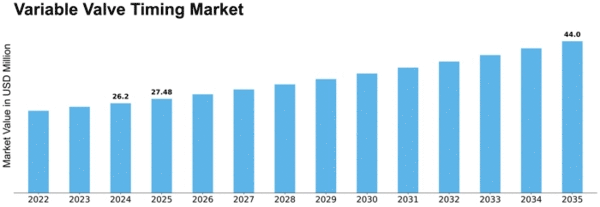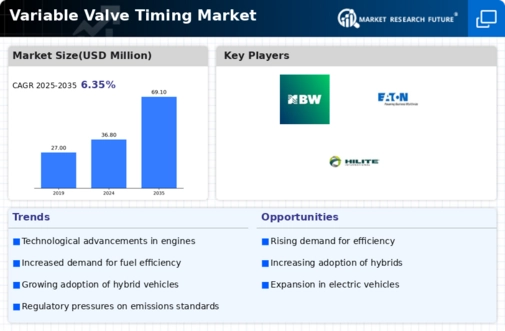-
EXECUTIVE SUMMARY
-
MARKET ATTRACTIVENESS ANALYSIS 19
-
GLOBAL
-
VARIABLE VALVE TIMING (VVT) MARKET, BY Technology 20
-
GLOBAL VARIABLE VALVE
-
TIMING (VVT) MARKET, BY Valve Train 21
-
GLOBAL VARIABLE VALVE TIMING (VVT)
-
MARKET, BY Vehicle Type 22
-
GLOBAL VARIABLE VALVE TIMING (VVT) MARKET, BY
-
Fuel Type 23
-
MARKET INTRODUCTION
-
DEFINITION 24
-
SCOPE
-
OF THE STUDY 24
-
LIST OF ASSUMPTIONS 25
-
MARKET STRUCTURE 25
-
RESEARCH METHODOLOGY
-
RESEARCH PROCESS 26
-
PRIMARY RESEARCH
-
SECONDARY RESEARCH 28
-
MARKET SIZE ESTIMATION 28
-
TOP-DOWN
-
and BOTTOM-up APPROACH 29
-
FORECAST MODEL 30
-
Key Sources 31
-
Market Dynamics
-
Introduction 32
-
Drivers 33
- Growing
- Drivers Impact
-
Stringent Engine Emission Regulations in Developed Countries 33
-
Demand for Enhanced Fuel Economy and Vehicle Performance 33
-
Analysis 35
-
Restraint 35
- Increased Sales of Electric Vehicles
- Restraints Impact Analysis 37
-
Opportunity 37
- Increasing
-
Incorporation of Electro-Hydraulic Camless Valve Actuation Systems 37
-
Challenge
- High Maintenance Cost 38
-
MARKET FACTOR ANALYSIS
-
Porter’s Five Forces Model 39
-
Bargaining Power of Suppliers 40
-
Threat of Substitutes 40
-
Variable valve timing (VVT) Market 41
-
Timing (VVT) 42
-
valve timing systems in Automotive 46
-
Threat of New Entrants 40
-
Bargaining Power of Buyers 40
-
Rivalry 40
-
Supply Chain Analysis: Global
- Design & Development 41
- Raw Material/Part Supply 41
- Manufacturing 42
- END USE
-
Technology Trends 42
- Multi Valve Timing in Variable Valve
-
Market Trends 42
- Rise in Vehicle Sales 42
-
Engine Emission Standards for key areas 44
-
nomenclature for variable
-
Global Variable valve timing
-
(VVT) Market, By Technology
-
Introduction 47
-
Cam-Phasing 47
-
Cam-Phasing Plus Changing 47
-
Others 47
-
Global Variable
-
valve timing (VVT) Market, By Valve Train
-
Introduction 49
-
Dual
-
Overhead Camshaft (DOHC) 49
-
Single Overhead Camshaft (SOHC) 49
-
Global Variable valve timing (VVT) Market, By Vehicle Type
-
Introduction
-
Passenger Vehicle 51
-
light Commercial Vehicle 51
-
heavy
-
Commercial Vehicle 52
-
Global Variable valve timing (VVT) Market, By
-
FUEL TYPE
-
Introduction 54
-
GASOLINE 54
-
Diesel 54
-
GLOBAL VARIABLE VALVE TIMING (VVT) MARKET, BY REGION
-
OVERVIEW 56
-
NORTH AMERICA 58
- North America: VARIABLE VALVE TIMING (VVT) MARKET,
- North America: Variable valve
-
by country, 2022-2030 (USD Million) 59
-
timing (VVT) Market, By Technology, 2022-2030 (USD Million) 59
-
North
-
America: Variable valve timing (VVT) Market, By Valve Train, 2022-2030 (USD Million)
-
North America: Variable valve timing (VVT) Market, By Vehicle Type,
-
North America: Variable valve timing (VVT)
-
Market, By FUEL TYPE, 2022-2030 (USD Million) 61
-
US 62
-
US: Variable valve timing (VVT) Market, By Technology, 2022-2030 (USD Million) 62
-
Million) 62
-
By FUEL TYPE, 2022-2030 (USD Million) 63
-
US: Variable valve timing (VVT) Market, By Valve Train, 2022-2030 (USD
-
US: Variable valve timing (VVT) Market, By Vehicle Type,
-
US: Variable valve timing (VVT) Market,
-
CANADA 64
-
CANADA:
-
Variable valve timing (VVT) Market, By Technology, 2022-2030 (USD Million) 64
-
(USD Million) 64
-
Type, 2022-2030 (USD Million) 65
-
CANADA: Variable valve timing (VVT) Market, By Valve Train, 2022-2030
-
CANADA: Variable valve timing (VVT) Market, By Vehicle
-
CANADA: Variable valve timing (VVT)
-
Market, By FUEL TYPE, 2022-2030 (USD Million) 65
-
Mexico 66
-
Mexico: Variable valve timing (VVT) Market, By Technology, 2022-2030 (USD Million)
-
(USD Million) 66
-
Type, 2022-2030 (USD Million) 67
-
Mexico: Variable valve timing (VVT) Market, By Valve Train, 2022-2030
-
Mexico: Variable valve timing (VVT) Market, By Vehicle
-
Mexico: Variable valve timing (VVT)
-
Market, By FUEL TYPE, 2022-2030 (USD Million) 67
-
EUROPE 68
-
Europe: Variable valve timing (VVT) Market, by country, 2022-2030 (USD MILLION)
-
(USD Million) 70
-
Train, 2022-2030 (USD Million) 70
-
Europe: Variable valve timing (VVT) Market, By Technology, 2022-2030
-
Europe: Variable valve timing (VVT) Market, By Valve
-
Europe: Variable valve timing (VVT)
-
Market, By Vehicle Type, 2022-2030 (USD Million) 71
-
Europe: Variable
-
valve timing (VVT) Market, By FUEL TYPE, 2022-2030 (USD Million) 71
-
Germany 72
-
By Technology, 2022-2030 (USD Million) 72
-
Germany: Variable valve timing (VVT) Market, By Technology,
-
Germany: Variable valve timing (VVT) Market,
-
Germany: Variable valve
-
timing (VVT) Market, By Vehicle Type, 2022-2030 (USD Million) 73
-
Germany:
-
Variable valve timing (VVT) Market, By FUEL TYPE, 2022-2030 (USD Million) 73
-
By Technology, 2022-2030 (USD Million) 74
-
UK 74
-
UK: Variable valve timing (VVT) Market,
-
UK: Variable valve timing
-
(VVT) Market, By Valve Train, 2022-2030 (USD Million) 74
-
UK: Variable
-
valve timing (VVT) Market, By Vehicle Type, 2022-2030 (USD Million) 75
-
UK: Variable valve timing (VVT) Market, By FUEL TYPE, 2022-2030 (USD Million) 75
-
Technology, 2022-2030 (USD Million) 76
-
France 76
-
France: Variable valve timing (VVT) Market, By
-
France: Variable valve timing
-
(VVT) Market, By Valve Train, 2022-2030 (USD Million) 76
-
France: Variable
-
valve timing (VVT) Market, By Vehicle Type, 2022-2030 (USD Million) 77
-
France: Variable valve timing (VVT) Market, By FUEL TYPE, 2022-2030 (USD Million)
-
By Technology, 2022-2030 (USD Million) 78
-
Italy 78
-
Italy: Variable valve timing (VVT) Market,
-
Italy: Variable valve timing
-
(VVT) Market, By Valve Train, 2022-2030 (USD Million) 78
-
Italy: Variable
-
valve timing (VVT) Market, By Vehicle Type, 2022-2030 (USD Million) 79
-
Italy: Variable valve timing (VVT) Market, By FUEL TYPE, 2022-2030 (USD Million)
-
By Technology, 2022-2030 (USD Million) 80
-
spain 80
-
Spain: Variable valve timing (VVT) Market,
-
Spain: Variable valve timing
-
(VVT) Market, By Valve Train, 2022-2030 (USD Million) 80
-
Spain: Variable
-
valve timing (VVT) Market, By Vehicle Type, 2022-2030 (USD Million) 81
-
Spain: Variable valve timing (VVT) Market, By FUEL TYPE, 2022-2030 (USD Million)
-
By Technology, 2022-2030 (USD Million) 82
-
Austria 82
-
Austria: Variable valve timing (VVT) Market,
-
Austria: Variable valve
-
timing (VVT) Market, By Valve Train, 2022-2030 (USD Million) 82
-
Austria:
-
Variable valve timing (VVT) Market, By Vehicle Type, 2022-2030 (USD Million) 83
-
(USD Million) 83
-
Austria: Variable valve timing (VVT) Market, By FUEL TYPE, 2022-2030
-
Rest of Europe 84
-
Rest of Europe: Variable
-
valve timing (VVT) Market, By Technology, 2022-2030 (USD Million) 84
-
Rest of Europe: Variable valve timing (VVT) Market, By Valve Train, 2022-2030 (USD
-
Million) 84
-
Vehicle Type, 2022-2030 (USD Million) 85
-
Rest of Europe: Variable valve timing (VVT) Market, By
-
Rest of Europe: Variable
-
valve timing (VVT) Market, By FUEL TYPE, 2022-2030 (USD Million) 85
-
ASIA-PACIFIC 86
- Asia-Pacific: Variable valve timing
-
(VVT) Market, by country, 2022-2030 (USD MILLION) 87
-
Asia-Pacific: Variable
-
valve timing (VVT) Market, By Technology, 2022-2030 (USD Million) 88
-
Asia-Pacific: Variable valve timing (VVT) Market, By Valve Train, 2022-2030 (USD
-
Million) 88
-
Type, 2022-2030 (USD Million) 89
-
Asia-Pacific: Variable valve timing (VVT) Market, By Vehicle
-
Asia-Pacific: Variable valve timing
-
(VVT) Market, By FUEL TYPE, 2022-2030 (USD Million) 89
-
China 90
-
China: Variable valve timing (VVT) Market, By Technology, 2022-2030 (USD Million)
-
(USD Million) 90
-
Type, 2022-2030 (USD Million) 90
-
China: Variable valve timing (VVT) Market, By Valve Train, 2022-2030
-
China: Variable valve timing (VVT) Market, By Vehicle
-
China: Variable valve timing (VVT)
-
Market, By FUEL TYPE, 2022-2030 (USD Million) 91
-
Japan 92
-
Japan: Variable valve timing (VVT) Market, By Technology, 2022-2030 (USD Million)
-
(USD Million) 92
-
Type, 2022-2030 (USD Million) 93
-
Japan: Variable valve timing (VVT) Market, By Valve Train, 2022-2030
-
Japan: Variable valve timing (VVT) Market, By Vehicle
-
Japan: Variable valve timing (VVT)
-
Market, By FUEL TYPE, 2022-2030 (USD Million) 93
-
India 94
-
India: Variable valve timing (VVT) Market, By Technology, 2022-2030 (USD Million)
-
(USD Million) 94
-
Type, 2022-2030 (USD Million) 95
-
India: Variable valve timing (VVT) Market, By Valve Train, 2022-2030
-
India: Variable valve timing (VVT) Market, By Vehicle
-
India: Variable valve timing (VVT)
-
Market, By FUEL TYPE, 2022-2030 (USD Million) 95
-
South Korea 96
-
South Korea: Variable valve timing (VVT) Market, By Technology, 2022-2030 (USD Million)
-
South Korea: Variable valve timing (VVT) Market, By Valve Train,
-
South Korea: Variable valve timing (VVT)
-
Market, By Vehicle Type, 2022-2030 (USD Million) 97
-
South Korea: Variable
-
valve timing (VVT) Market, By FUEL TYPE, 2022-2030 (USD Million) 97
-
Australia 98
-
Australia: Variable valve timing (VVT) Market, By Technology,
-
Australia: Variable valve timing (VVT)
-
Market, By Valve Train, 2022-2030 (USD Million) 98
-
Australia: Variable
-
valve timing (VVT) Market, By Vehicle Type, 2022-2030 (USD Million) 99
-
Australia: Variable valve timing (VVT) Market, By FUEL TYPE, 2022-2030 (USD Million)
-
Rest of Asia Pacific 100
-
Rest of Asia Pacific: Variable valve timing (VVT) Market, By Technology, 2022-2030
-
(USD Million) 100
-
Rest of Asia Pacific: Variable valve timing (VVT)
-
Market, By Valve Train, 2022-2030
-
(USD Million) 100
-
Rest of
-
Asia Pacific: Variable valve timing (VVT) Market, By Vehicle Type, 2022-2030
-
(USD Million) 101
-
Rest of Asia Pacific: Variable valve timing (VVT)
-
Market, By FUEL TYPE, 2022-2030
-
(USD Million) 101
-
Rest of the World
- row: Variable valve timing (VVT) Market, by Region, 2022-2030 (USD
- row: Variable valve timing (VVT) Market, By Technology,
- row: Variable valve timing (VVT) Market,
- row: Variable valve timing
-
MILLION) 103
-
By Valve Train, 2022-2030 (USD Million) 104
-
(VVT) Market, By Vehicle Type, 2022-2030 (USD Million) 105
-
row: Variable
-
valve timing (VVT) Market, By FUEL TYPE, 2022-2030 (USD Million) 105
-
Middle East & Africa 106
-
Middle East & Africa: Variable valve
-
timing (VVT) Market, By Technology, 2022-2030
-
(USD Million) 106
-
Middle East & Africa: Variable valve timing (VVT) Market, By Valve Train, 2022-2030
-
(USD Million) 106
-
Middle East & Africa: Variable valve timing
-
(VVT) Market, By Vehicle Type, 2022-2030
-
(USD Million) 107
-
Middle
-
East & Africa: Variable valve timing (VVT) Market, By FUEL TYPE, 2022-2030
-
(USD Million) 107
-
South America 108
-
South America: Variable
-
valve timing (VVT) Market, By Technology, 2022-2030 (USD Million) 108
-
South America: Variable valve timing (VVT) Market, By Valve Train, 2022-2030 (USD
-
Million) 108
-
Vehicle Type, 2022-2030 (USD Million) 109
-
South America: Variable valve timing (VVT) Market, By
-
South America: Variable
-
valve timing (VVT) Market, By FUEL TYPE, 2022-2030 (USD Million) 109
-
Competitive Landscape
-
Introduction 110
-
Global Variable Valve
-
Timing (VVT) MAJOR Players Market Share Analysis 110
-
COMPETITIVE BENCHMARKING
-
Key developments in the global Variable Valve Timing (VVT) market
- Key developments: Joint Venture 111
- Key developments:
- Key developments: Expansion 112
-
Product Development 112
-
COMPANY PROFILES
-
DENSO CORPORATION 113
- COMPANY OVERVIEW 113
- FINANCIAL OVERVIEW 114
- PRODUCTS OFFERED 114
- KEY
- SWOT ANALYSIS 116
- KEY STRATEGIES 116
-
DEVELOPMENTS 115
-
Delphi Technologies 117
- COMPANY OVERVIEW 117
- FINANCIAL
- PRODUCTS OFFERED 118
- KEY DEVELOPMENTS 119
- SWOT ANALYSIS 119
- KEY STRATEGIES 119
-
OVERVIEW 118
-
AISIN SEIKI
- COMPANY OVERVIEW 120
- FINANCIAL OVERVIEW 121
- PRODUCTS OFFERED 121
- KEY DEVELOPMENTS 121
- SWOT
- KEY STRATEGIES 122
-
Co., Ltd 120
-
ANALYSIS 122
-
BorgWarner Inc. 123
- FINANCIAL OVERVIEW 124
- PRODUCTS OFFERED
- KEY DEVELOPMENTS 125
- SWOT ANALYSIS 126
- KEY
-
COMPANY OVERVIEW 123
-
STRATEGIES 126
-
Eaton 127
- COMPANY OVERVIEW 127
- PRODUCTS OFFERED 128
- KEY DEVELOPMENTS
- KEY STRATEGIES 129
-
FINANCIAL OVERVIEW 128
-
Hitachi, Ltd. 129
- FINANCIAL OVERVIEW 130
- PRODUCTS OFFERED
- KEY DEVELOPMENTS 130
- KEY STRATEGIES 130
-
COMPANY OVERVIEW 129
-
Schaeffler
- COMPANY OVERVIEW 131
- FINANCIAL OVERVIEW 132
- KEY DEVELOPMENTS 133
- SWOT ANALYSIS
- KEY STRATEGIES 133
-
AG 131
-
PRODUCTS OFFERED 132
-
Mitsubishi Electric Corporation 134
- COMPANY OVERVIEW 134
- FINANCIAL OVERVIEW 135
- PRODUCTS
- KEY DEVELOPMENTS 135
- Key Strategies 135
- COMPANY OVERVIEW 136
- FINANCIAL
- PRODUCTS OFFERED 136
- KEY DEVELOPMENTS 136
- Key Strategies 137
-
OFFERED 135
-
Hilite International 136
-
OVERVIEW 136
-
Husco International 138
- COMPANY
- FINANCIAL OVERVIEW 138
- PRODUCTS OFFERED 138
- KEY DEVELOPMENTS 138
- Key Strategies 138
-
OVERVIEW 138
-
Sumitomo
- COMPANY OVERVIEW 139
- FINANCIAL
- PRODUCTS OFFERED 140
- KEY DEVELOPMENTS 141
- Key Strategies 141
-
Electric Industries, Ltd 139
-
OVERVIEW 140
-
LIST OF TABLES
-
LIST OF ASSUMPTIONS
-
PROGRESS IN AVERAGE FUEL ECONOMY IMPROVEMENT IN THE WORLD AND GFEI
-
TARGETS FOR 2030 34
-
GLOBAL VARIABLE VALVE TIMING (VVT) MARKET, BY TECHNOLOGY,
-
GLOBAL VARIABLE VALVE TIMING (VVT) MARKET,
-
BY VALVE TRAIN, 2022-2030 (USD MILLION) 50
-
GLOBAL VARIABLE VALVE TIMING
-
(VVT) MARKET, BY VEHICLE TYPE, 2022-2030 (USD MILLION) 52
-
GLOBAL VARIABLE
-
VALVE TIMING (VVT) MARKET, BY FUEL TYPE, 2022-2030 (USD MILLION) 55
-
TABLE 7
-
GLOBAL VARIABLE VALVE TIMING (VVT) MARKET, BY REGION, 2022-2030 (USD MILLION) 57
-
NORTH AMERICA: VARIABLE VALVE TIMING (VVT) MARKET, BY COUNTRY, 2022-2030
-
(USD MILLION) 59
-
NORTH AMERICA: VARIABLE VALVE TIMING (VVT) MARKET,
-
BY TECHNOLOGY, 2022-2030 (USD MILLION) 59
-
NORTH AMERICA: VARIABLE
-
VALVE TIMING (VVT) MARKET, BY VALVE TRAIN, 2022-2030 (USD MILLION) 60
-
TABLE
-
NORTH AMERICA: VARIABLE VALVE TIMING (VVT) MARKET, BY VEHICLE TYPE, 2022-2030
-
(USD MILLION) 60
-
NORTH AMERICA: VARIABLE VALVE TIMING (VVT) MARKET,
-
BY FUEL TYPE, 2022-2030 (USD MILLION) 61
-
US: VARIABLE VALVE TIMING
-
(VVT) MARKET, BY TECHNOLOGY, 2022-2030 (USD MILLION) 62
-
US: VARIABLE
-
VALVE TIMING (VVT) MARKET, BY VALVE TRAIN, 2022-2030 (USD MILLION) 62
-
TABLE
-
US: VARIABLE VALVE TIMING (VVT) MARKET, BY VEHICLE TYPE, 2022-2030 (USD MILLION)
-
US: VARIABLE VALVE TIMING (VVT) MARKET, BY FUEL TYPE, 2022-2030
-
(USD MILLION) 63
-
CANADA: VARIABLE VALVE TIMING (VVT) MARKET, BY TECHNOLOGY,
-
CANADA: VARIABLE VALVE TIMING (VVT) MARKET,
-
BY VALVE TRAIN, 2022-2030 (USD MILLION) 64
-
CANADA: VARIABLE VALVE
-
TIMING (VVT) MARKET, BY VEHICLE TYPE, 2022-2030 (USD MILLION) 65
-
CANADA:
-
VARIABLE VALVE TIMING (VVT) MARKET, BY FUEL TYPE, 2022-2030 (USD MILLION) 65
-
MEXICO: VARIABLE VALVE TIMING (VVT) MARKET, BY TECHNOLOGY, 2022-2030
-
(USD MILLION) 66
-
MEXICO: VARIABLE VALVE TIMING (VVT) MARKET, BY VALVE
-
TRAIN, 2022-2030 (USD MILLION) 66
-
MEXICO: VARIABLE VALVE TIMING (VVT)
-
MARKET, BY VEHICLE TYPE, 2022-2030 (USD MILLION) 67
-
MEXICO: VARIABLE
-
VALVE TIMING (VVT) MARKET, BY FUEL TYPE, 2022-2030 (USD MILLION) 67
-
TABLE 25
-
EUROPE: VARIABLE VALVE TIMING (VVT) MARKET, BY COUNTRY, 2022-2030 (USD MILLION)
-
EUROPE: VARIABLE VALVE TIMING (VVT) MARKET, BY TECHNOLOGY, 2022-2030
-
(USD MILLION) 70
-
EUROPE: VARIABLE VALVE TIMING (VVT) MARKET, BY VALVE
-
TRAIN, 2022-2030 (USD MILLION) 70
-
EUROPE: VARIABLE VALVE TIMING (VVT)
-
MARKET, BY VEHICLE TYPE, 2022-2030 (USD MILLION) 71
-
EUROPE: VARIABLE
-
VALVE TIMING (VVT) MARKET, BY FUEL TYPE, 2022-2030 (USD MILLION) 71
-
TABLE 30
-
GERMANY: VARIABLE VALVE TIMING (VVT) MARKET, BY TECHNOLOGY, 2022-2030 (USD MILLION)
-
GERMANY: VARIABLE VALVE TIMING (VVT) MARKET, BY VALVE TRAIN, 2022-2030
-
(USD MILLION) 72
-
GERMANY: VARIABLE VALVE TIMING (VVT) MARKET, BY VEHICLE
-
TYPE, 2022-2030 (USD MILLION) 73
-
GERMANY: VARIABLE VALVE TIMING (VVT)
-
MARKET, BY FUEL TYPE, 2022-2030 (USD MILLION) 73
-
UK: VARIABLE VALVE
-
TIMING (VVT) MARKET, BY TECHNOLOGY, 2022-2030 (USD MILLION) 74
-
UK:
-
VARIABLE VALVE TIMING (VVT) MARKET, BY VALVE TRAIN, 2022-2030 (USD MILLION) 74
-
UK: VARIABLE VALVE TIMING (VVT) MARKET, BY VEHICLE TYPE, 2022-2030 (USD
-
MILLION) 75
-
UK: VARIABLE VALVE TIMING (VVT) MARKET, BY FUEL TYPE,
-
FRANCE: VARIABLE VALVE TIMING (VVT) MARKET,
-
BY TECHNOLOGY, 2022-2030 (USD MILLION) 76
-
FRANCE: VARIABLE VALVE TIMING
-
(VVT) MARKET, BY VALVE TRAIN, 2022-2030 (USD MILLION) 76
-
FRANCE: VARIABLE
-
VALVE TIMING (VVT) MARKET, BY VEHICLE TYPE, 2022-2030 (USD MILLION) 77
-
TABLE
-
FRANCE: VARIABLE VALVE TIMING (VVT) MARKET, BY FUEL TYPE, 2022-2030 (USD MILLION)
-
ITALY: VARIABLE VALVE TIMING (VVT) MARKET, BY TECHNOLOGY, 2022-2030
-
(USD MILLION) 78
-
ITALY: VARIABLE VALVE TIMING (VVT) MARKET, BY VALVE
-
TRAIN, 2022-2030 (USD MILLION) 78
-
ITALY: VARIABLE VALVE TIMING (VVT)
-
MARKET, BY VEHICLE TYPE, 2022-2030 (USD MILLION) 79
-
ITALY: VARIABLE
-
VALVE TIMING (VVT) MARKET, BY FUEL TYPE, 2022-2030 (USD MILLION) 79
-
TABLE 46
-
SPAIN: VARIABLE VALVE TIMING (VVT) MARKET, BY TECHNOLOGY, 2022-2030 (USD MILLION)
-
SPAIN: VARIABLE VALVE TIMING (VVT) MARKET, BY VALVE TRAIN, 2022-2030
-
(USD MILLION) 80
-
SPAIN: VARIABLE VALVE TIMING (VVT) MARKET, BY VEHICLE
-
TYPE, 2022-2030 (USD MILLION) 81
-
SPAIN: VARIABLE VALVE TIMING (VVT)
-
MARKET, BY FUEL TYPE, 2022-2030 (USD MILLION) 81
-
AUSTRIA: VARIABLE
-
VALVE TIMING (VVT) MARKET, BY TECHNOLOGY, 2022-2030 (USD MILLION) 82
-
TABLE
-
AUSTRIA: VARIABLE VALVE TIMING (VVT) MARKET, BY VALVE TRAIN, 2022-2030 (USD MILLION)
-
AUSTRIA: VARIABLE VALVE TIMING (VVT) MARKET, BY VEHICLE TYPE, 2022-2030
-
(USD MILLION) 83
-
AUSTRIA: VARIABLE VALVE TIMING (VVT) MARKET, BY FUEL
-
TYPE, 2022-2030 (USD MILLION) 83
-
REST OF EUROPE: VARIABLE VALVE TIMING
-
(VVT) MARKET, BY TECHNOLOGY, 2022-2030 (USD MILLION) 84
-
REST OF EUROPE:
-
VARIABLE VALVE TIMING (VVT) MARKET, BY VALVE TRAIN, 2022-2030 (USD MILLION) 84
-
REST OF EUROPE: VARIABLE VALVE TIMING (VVT) MARKET, BY VEHICLE TYPE,
-
REST OF EUROPE: VARIABLE VALVE TIMING (VVT)
-
MARKET, BY FUEL TYPE, 2022-2030 (USD MILLION) 85
-
ASIA-PACIFIC: VARIABLE
-
VALVE TIMING (VVT) MARKET, BY COUNTRY, 2022-2030 (USD MILLION) 87
-
TABLE 59
-
ASIA-PACIFIC: VARIABLE VALVE TIMING (VVT) MARKET, BY TECHNOLOGY, 2022-2030 (USD
-
MILLION) 88
-
ASIA-PACIFIC: VARIABLE VALVE TIMING (VVT) MARKET, BY VALVE
-
TRAIN, 2022-2030 (USD MILLION) 88
-
ASIA-PACIFIC: VARIABLE VALVE TIMING
-
(VVT) MARKET, BY VEHICLE TYPE, 2022-2030 (USD MILLION) 89
-
ASIA-PACIFIC:
-
VARIABLE VALVE TIMING (VVT) MARKET, BY FUEL TYPE, 2022-2030 (USD MILLION) 89
-
CHINA: VARIABLE VALVE TIMING (VVT) MARKET, BY TECHNOLOGY, 2022-2030 (USD
-
MILLION) 90
-
CHINA: VARIABLE VALVE TIMING (VVT) MARKET, BY VALVE TRAIN,
-
CHINA: VARIABLE VALVE TIMING (VVT) MARKET,
-
BY VEHICLE TYPE, 2022-2030 (USD MILLION) 90
-
CHINA: VARIABLE VALVE
-
TIMING (VVT) MARKET, BY FUEL TYPE, 2022-2030 (USD MILLION) 91
-
JAPAN:
-
VARIABLE VALVE TIMING (VVT) MARKET, BY TECHNOLOGY, 2022-2030 (USD MILLION) 92
-
JAPAN: VARIABLE VALVE TIMING (VVT) MARKET, BY VALVE TRAIN, 2022-2030
-
(USD MILLION) 92
-
JAPAN: VARIABLE VALVE TIMING (VVT) MARKET, BY VEHICLE
-
TYPE, 2022-2030 (USD MILLION) 93
-
JAPAN: VARIABLE VALVE TIMING (VVT)
-
MARKET, BY FUEL TYPE, 2022-2030 (USD MILLION) 93
-
INDIA: VARIABLE VALVE
-
TIMING (VVT) MARKET, BY TECHNOLOGY, 2022-2030 (USD MILLION) 94
-
INDIA:
-
VARIABLE VALVE TIMING (VVT) MARKET, BY VALVE TRAIN, 2022-2030 (USD MILLION) 94
-
INDIA: VARIABLE VALVE TIMING (VVT) MARKET, BY VEHICLE TYPE, 2022-2030
-
(USD MILLION) 95
-
INDIA: VARIABLE VALVE TIMING (VVT) MARKET, BY FUEL
-
TYPE, 2022-2030 (USD MILLION) 95
-
SOUTH KOREA: VARIABLE VALVE TIMING
-
(VVT) MARKET, BY TECHNOLOGY, 2022-2030 (USD MILLION) 96
-
SOUTH KOREA:
-
VARIABLE VALVE TIMING (VVT) MARKET, BY VALVE TRAIN, 2022-2030 (USD MILLION) 96
-
SOUTH KOREA: VARIABLE VALVE TIMING (VVT) MARKET, BY VEHICLE TYPE, 2022-2030
-
(USD MILLION) 97
-
SOUTH KOREA: VARIABLE VALVE TIMING (VVT) MARKET,
-
BY FUEL TYPE, 2022-2030 (USD MILLION) 97
-
AUSTRALIA: VARIABLE VALVE
-
TIMING (VVT) MARKET, BY TECHNOLOGY, 2022-2030 (USD MILLION) 98
-
AUSTRALIA:
-
VARIABLE VALVE TIMING (VVT) MARKET, BY VALVE TRAIN, 2022-2030 (USD MILLION) 98
-
AUSTRALIA: VARIABLE VALVE TIMING (VVT) MARKET, BY VEHICLE TYPE, 2022-2030
-
(USD MILLION) 99
-
AUSTRALIA: VARIABLE VALVE TIMING (VVT) MARKET, BY
-
FUEL TYPE, 2022-2030 (USD MILLION) 99
-
REST OF ASIA PACIFIC: VARIABLE
-
VALVE TIMING (VVT) MARKET, BY TECHNOLOGY, 2022-2030 (USD MILLION) 100
-
TABLE
-
REST OF ASIA PACIFIC: VARIABLE VALVE TIMING (VVT) MARKET, BY VALVE TRAIN, 2022-2030
-
(USD MILLION) 100
-
REST OF ASIA PACIFIC: VARIABLE VALVE TIMING (VVT)
-
MARKET, BY VEHICLE TYPE, 2022-2030 (USD MILLION) 101
-
REST OF ASIA
-
PACIFIC: VARIABLE VALVE TIMING (VVT) MARKET, BY FUEL TYPE, 2022-2030 (USD MILLION)
-
ROW: VARIABLE VALVE TIMING (VVT) MARKET, BY REGION, 2022-2030
-
(USD MILLION) 103
-
ROW: VARIABLE VALVE TIMING (VVT) MARKET, BY TECHNOLOGY,
-
ROW: VARIABLE VALVE TIMING (VVT) MARKET,
-
BY VALVE TRAIN, 2022-2030 (USD MILLION) 104
-
ROW: VARIABLE VALVE TIMING
-
(VVT) MARKET, BY VEHICLE TYPE, 2022-2030 (USD MILLION) 105
-
ROW: VARIABLE
-
VALVE TIMING (VVT) MARKET, BY FUEL TYPE, 2022-2030 (USD MILLION) 105
-
TABLE
-
MIDDLE EAST & AFRICA: VARIABLE VALVE TIMING (VVT) MARKET, BY TECHNOLOGY,
-
MIDDLE EAST & AFRICA: VARIABLE VALVE
-
TIMING (VVT) MARKET, BY VALVE TRAIN, 2022-2030 (USD MILLION) 106
-
MIDDLE
-
EAST & AFRICA: VARIABLE VALVE TIMING (VVT) MARKET, BY VEHICLE TYPE, 2022-2030
-
(USD MILLION) 107
-
MIDDLE EAST & AFRICA: VARIABLE VALVE TIMING
-
(VVT) MARKET, BY FUEL TYPE, 2022-2030 (USD MILLION) 107
-
SOUTH AMERICA:
-
VARIABLE VALVE TIMING (VVT) MARKET, BY TECHNOLOGY, 2022-2030 (USD MILLION) 108
-
SOUTH AMERICA: VARIABLE VALVE TIMING (VVT) MARKET, BY VALVE TRAIN, 2022-2030
-
(USD MILLION) 108
-
SOUTH AMERICA: VARIABLE VALVE TIMING (VVT) MARKET,
-
BY VEHICLE TYPE, 2022-2030 (USD MILLION) 109
-
SOUTH AMERICA: VARIABLE
-
VALVE TIMING (VVT) MARKET, BY FUEL TYPE, 2022-2030 (USD MILLION) 109
-
TABLE
-
BENCHMARKING OF MAJOR COMPETITORS 111
-
DENSO CORPORATION: PRODUCTS
-
OFFERED 114
-
DENSO CORPORATION: KEY DEVELOPMENTS 115
-
TABLE 103
-
DELPHI TECHNOLOGIES: PRODUCTS OFFERED 118
-
AISIN SEIKI CO., LTD.:
-
PRODUCTS OFFERED 121
-
AISIN SEIKI CO., LTD.: KEY DEVELOPMENTS 121
-
BORGWARNER INC.: PRODUCTS OFFERED 124
-
BORGWARNER INC.:
-
KEY DEVELOPMENTS 125
-
EATON: PRODUCTS OFFERED 128
-
HITACHI,
-
LTD.: PRODUCTS OFFERED 130
-
SCHAEFFLER AG: FINANCIAL OVERVIEW SNAPSHOT
-
SCHAEFFLER AG: PRODUCTS OFFERED 132
-
MITSUBISHI
-
ELECTRIC CORPORATION: PRODUCTS OFFERED 135
-
HILITE INTERNATIONAL:
-
PRODUCTS OFFERED 136
-
HILITE INTERNATIONAL: KEY DEVELOPMENTS 136
-
HUSCO INTERNATIONAL: PRODUCTS OFFERED 138
-
SUMITOMO ELECTRIC
-
INDUSTRIES, LTD: PRODUCTS OFFERED 140
-
LIST OF FIGURES
-
FIGURE
-
MARKET SYNOPSIS 18
-
MARKET ATTRACTIVENESS ANALYSIS: GLOBAL VARIABLE
-
VALVE TIMING (VVT) MARKET 19
-
GLOBAL VARIABLE VALVE TIMING (VVT) MARKET
-
ANALYSIS, BY TECHNOLOGY 20
-
GLOBAL VARIABLE VALVE TIMING (VVT) MARKET
-
ANALYSIS, BY VALVE TRAIN 21
-
GLOBAL VARIABLE VALVE TIMING (VVT) MARKET
-
ANALYSIS, BY VEHICLE TYPE 22
-
GLOBAL VARIABLE VALVE TIMING (VVT) MARKET
-
ANALYSIS, BY FUEL TYPE 23
-
GLOBAL VARIABLE VALVE TIMING (VVT) MARKET:
-
MARKET STRUCTURE 25
-
RESEARCH PROCESS OF MRFR 26
-
DROC
-
ANALYSIS: GLOBAL VARIABLE VALVE TIMING (VVT) MARKET 32
-
DRIVERS IMPACT
-
ANALYSIS: GLOBAL VARIABLE VALVE TIMING (VVT) MARKET 35
-
TOTAL NUMBER
-
OF ELECTRIC CARS ON THE ROAD, 2013–2017 (MILLIONS) 36
-
RESTRAINTS
-
IMPACT ANALYSIS: GLOBAL VARIABLE VALVE TIMING (VVT) MARKET 37
-
GLOBAL
-
VARIABLE VALVE TIMING (VVT) MARKET: PORTER ANALYSIS 39
-
SUPPLY CHAIN:
-
GLOBAL VARIABLE VALVE TIMING (VVT) MARKET 41
-
GLOBAL VEHICLE SALE
-
(IN MILLION UNITS), 2012–2017 43
-
GLOBAL VARIABLE VALVE TIMING
-
(VVT) MARKET, BY TECHNOLOGY, 2022 (% SHARE) 48
-
GLOBAL VARIABLE VALVE
-
TIMING (VVT) MARKET, BY VALVE TRAIN, 2022 (% SHARE) 49
-
GLOBAL VARIABLE
-
VALVE TIMING (VVT) MARKET, BY VEHICLE TYPE, 2022 (% SHARE) 52
-
GLOBAL
-
VARIABLE VALVE TIMING (VVT) MARKET, BY FUEL TYPE, 2022 (% SHARE) 54
-
FIGURE
-
GLOBAL VARIABLE VALVE TIMING (VVT) MARKET, BY REGION, 2022 (% SHARE) 56
-
FIGURE
-
NORTH AMERICA: VARIABLE VALVE TIMING (VVT) MARKET SHARE, BY COUNTRY, 2025 (%
-
SHARE) 58
-
EUROPE: VARIABLE VALVE TIMING (VVT) MARKET SHARE, BY COUNTRY,
-
ASIA-PACIFIC: VARIABLE VALVE TIMING (VVT) MARKET
-
SHARE, BY COUNTRY, 2022 (% SHARE) 87
-
ROW: VARIABLE VALVE TIMING (VVT)
-
MARKET SHARE, BY REGION, 2022 (% SHARE) 103
-
GLOBAL VARIABLE VALVE
-
TIMING (VVT) MAJOR PLAYERS MARKET SHARE ANALYSIS, 2022 (%) 110
-
KEY
-
DEVELOPMENTS: JOINT VENTURE 111
-
KEY DEVELOPMENTS: PRODUCT DEVELOPMENT
-
KEY DEVELOPMENTS: EXPANSION 112
-
DENSO CORPORATION:
-
FINANCIAL OVERVIEW SNAPSHOT 114
-
DENSO CORPORATION: SWOT ANALYSIS
-
DELPHI TECHNOLOGIES: FINANCIAL OVERVIEW SNAPSHOT 118
-
FIGURE
-
DELPHI TECHNOLOGIES: SWOT ANALYSIS 119
-
AISIN SEIKI CO., LTD.:
-
FINANCIAL OVERVIEW SNAPSHOT 121
-
AISIN SEIKI CO., LTD.: SWOT ANALYSIS
-
BORGWARNER INC.: FINANCIAL OVERVIEW SNAPSHOT 124
-
FIGURE
-
BORGWARNER INC.: SWOT ANALYSIS 126
-
EATON: FINANCIAL OVERVIEW SNAPSHOT
-
HITACHI, LTD.: FINANCIAL OVERVIEW SNAPSHOT 130
-
FIGURE 39
-
SCHAEFFLER AG: SWOT ANALYSIS 133
-
MITSUBISHI ELECTRIC CORPORATION:
-
FINANCIAL OVERVIEW SNAPSHOT 135
-
SUMITOMO ELECTRIC INDUSTRIES LTD:
-
FINANCIAL OVERVIEW SNAPSHOT 140


















Leave a Comment